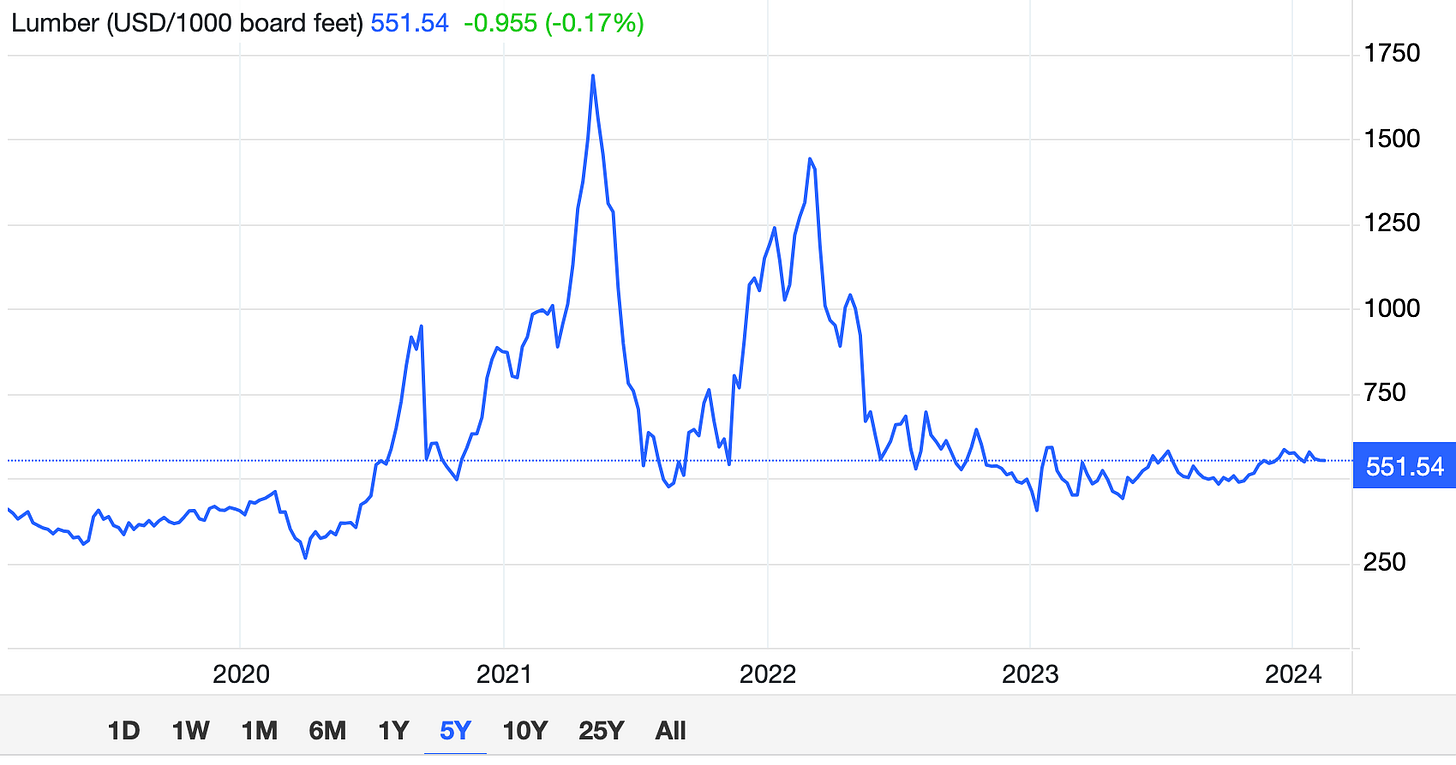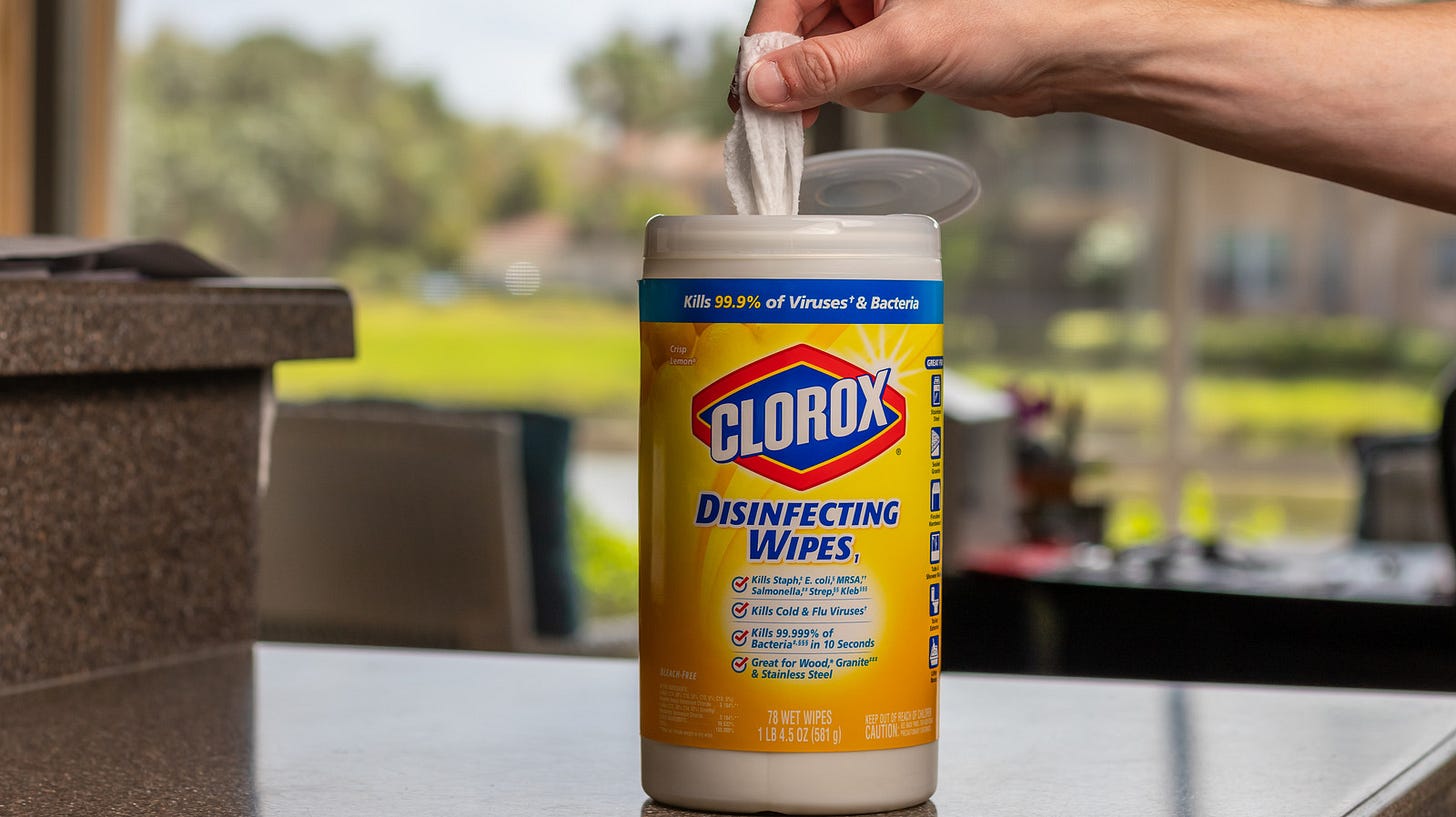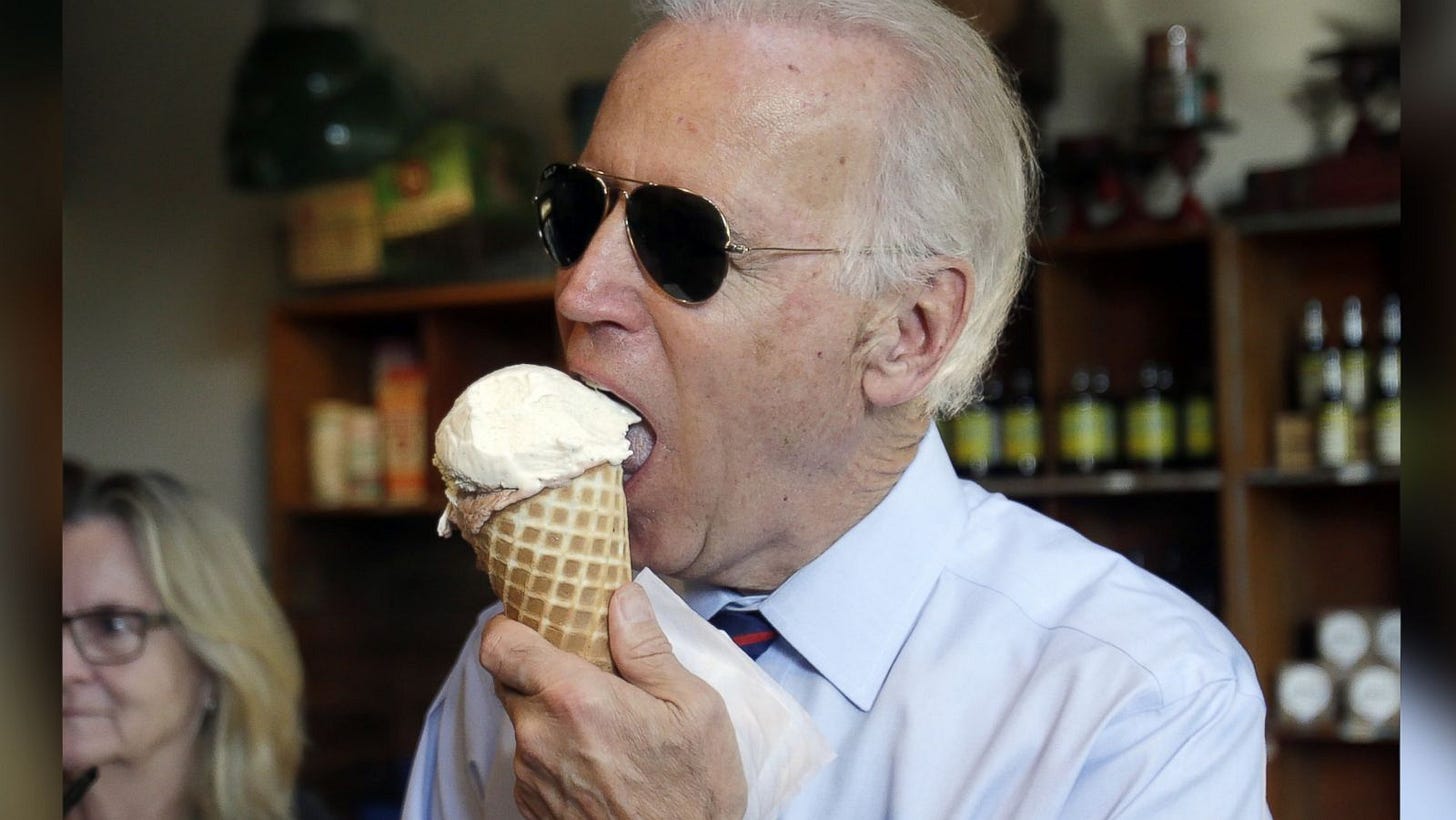Biden's Super Bowl Shrinkflation
The president doesn't appear to have any idea what he's talking about
President Joe Biden, for the second year in a row, decided last week to skip the traditional Super Bowl pre-game presidential interview. According to the White House, the decision was made because viewers “wanted to watch football, not the president.”
While I appreciate his concern for my viewing habits, it is curious that a sitting president would pass up an opportunity to talk to the single largest television audience in America. One would think that in the middle of a difficult re-election fight, with his approval rating stuck around thirty-eight percent and whispers circulating that he is experiencing significant cognitive decline, he would relish the opportunity to speak on his own behalf.
But Biden did want to talk to us after all, it seems. Not by sitting down for a softball interview with a journalist, mind you. Apparently, the president was more interested in putting together something he could control and release himself.
Thus in the leadup to the game on Sunday, Team Biden released the following video on X, complete with bongo drums, quick cuts and b-roll of potato chips:
If you don’t want to click on the video, here’s the transcript:
It’s super bowl Sunday. If you’re anything like me, you like to be surrounded by a snack or two while watching the big game. You know, while buying snacks for the game you might have noticed one thing: sports drinks bottles are smaller. A bag of chips has fewer chips, but they’re still charging us just as much. As an ice cream lover, what makes me the most angry is that ice cream cartons have actually shrunk in size, but not in price. I’ve had enough of what they call shrinkflation. It’s a ripoff. Some companies are trying to pull a fast one by shrinking the products little by little and hoping you won’t notice. Give me a break. The American public is tired of being played for suckers. I’m calling on companies to put a stop to this. Let’s make sure businesses do the right thing now.
If you have never heard of shrinkflation, don’t worry, I doubt you are alone.
It is, however, a real economic concept. The word is an obvious portmanteau of “shrink” and “inflation,” two words that describe the phenomenon well. Shrinkflation is the process by which consumer goods (particularly convenience food items) decrease in size or quantity over time, while the price remains the same.
There are many reasons this happens, which I’ll get to in a moment, but usually it coincides with price increases in things needed in the production of goods — labor, ingredients, transportation — which in turn increase production costs, forcing producers to either raise prices of their product or change the quantity or size to maintain the price.
Biden says this practice is rampant, it is due to corporate greed, and he is having none of it. “Give me a break,” he says to us in his what grinds my gears rant-video.
But is there any merit to what he is saying? Is shrinkflation happening, and if so Biden right that it is due to the lust for profit in corporate America? Or is it perhaps due to other factors? What’s really going on here?
In December, Senator Bob Casey (D-PA) released what he called a “greedflation report,” that examined the data behind the supposed shrinkflation that is taking place in our economy. The report claimed that snack foods, which Biden also complained about in his video, were up by 26.4 percent since 2019, with 9.8 percent of the increase coming from shrinking portions.
In addition common household products like paper towels and toilet paper up 34.9 percent over the same period, with roughly 10.3 percent of the increase being attributable to smaller rolls and packages.
The contention being made by Casey, and by extension, Biden, is that corporations are attempting to obfuscate their intentions to fleece consumers, giving themselves higher profits in the process. They are doing this in part by shrinking their products, or so the logic goes.
The problems with this analysis are numerous. The first is that Casey’s office manipulates data to make shrinkflation sound worse than it is. Note the chart above, and how the percent of measured price increase attributable to shrinkflation data is calculated. Snacks rose by a total of 26.4 percent, as noted before, but 23.9 percent of that rise is a unit price change that excludes shrinkflation. The actual percentage that should be considered attributable to shrinkflation is 2.5 percent, not 9.8 percent, but by working the math against the total price change, they can give themselves a bigger, scarier number.
Not that Casey’s methodology makes much sense anyway. It is flawed and does not take seriously key inflation indicators over the periods studied, which has of course become a serious concern for Americans as prices have risen by roughly 18 percent since 2019.
Remember that the general inflation rate covers a lot of ground, and there are specific categories within the overall trend that are better or worse. Food happens to be one of those “worse” categories. Since 2019, the same period looked at by Casey’s report, food and drink prices have actually risen 23 percent, instantly explaining nearly all of the the 26.4 percent snack food inflation observed in the report. This is particularly true when you consider that even within the food category, different products that rely on certain types of crops or ingredients will be more or less expensive than that baseline 23 percent.
The same would likely be true if you evaluated prices in papermaking or any other category they studied. For paper products, the large increases we have seen in this area are likely attributable to the two-year plus spike in lumber prices, which had skyrocketed from around $400 per thousand feet pre-pandemic to as high as $1686 per thousand feet in 2021.
Neither Casey nor Biden have the slightest idea what fluctuations exist within production costs for any of these companies, or any other industry-specific issues related to profit and loss. They have simply decided that the combination of rising costs and shrinking products must be due to greed.
Because, reasons.
Feeding this belief is an anecdotal, selective and flawed review of data from certain corporations, and an army of progressive think-tanks that argue corporate profits are to blame for inflation and that the record profits seen recently are little more than unbridled avarice.
For instance, on social media some Biden supporters pointed the finger at Clorox, demanding that the company “explain” how a 70-count container of wipes became a 35-count container while the price stayed the same. “It's very obvious to consumers,” one individual said, “that companies took the COVID opportunity to stick it to them.”
This underhanded behavior by Clorox has resulted in, apparently, “record profits.” To back up this claim, they point to an increase in corporate revenues from $6.72 billion in 2020 to $7.4 billion in 2023, which could suggest that Clorox might be profiteering, padding their wallets by “sticking it” to consumers.
Alas, those corporate profit numbers do not account for inflation. If they had, they would’ve had to account for the annual inflation rate (4.7 percent in 2021, 8 percent in 2022 and 4.1 percent in 2023) in overall expectations. Taking inflation into account would have made the original $6.72 billion in revenue in 2020 worth $7.91 billion by 2023 if Clorox had simply maintained its revenue after 2020. In reality, the actual revenue being $7.4 billion means that they took in about $500 million dollars less than they would've had they kept revenue even over time.
The bigger problem, though, is more fundamental. Critics looked at annual revenue for the company, not annual profit. If they had, they would have seen that Clorox's annual gross profit has fallen from $3.2 billion in 2021 to $2.9 billion in 2023. That makes for a difficult case that Clorox is fleecing customers to pad profits.
But the argument is even weaker than that. Gross profit is simply the profit that comes from revenue minus the cost of goods sold. But there are a lot of additional costs for a company that impact profitability, things like additional expenses for the company to operate and sell like advertising, administration, taxes, and much more. The statistic that should probably matter to an honest evaluation is net income, which calculates the net profit or loss after all revenues, income items, and expenses have been accounted for.
That number for Clorox is not only smaller, but trending in an awful direction for the company. In 2020, net income was $939 million, and over time it has decreased to $710 million in 2021, $462 million in 2022, and only $149 million in 2023. Clorox has had negative year-over-year quarterly growth for five out of the last ten quarters.
But let’s pretend for a moment that these people are right. Let’s say it is greed. Let’s say companies are gouging you. This brings us to the fundamental misunderstanding about capitalism that lies beneath all of this nonsense.
When all is said and done, markets create a mechanism whereby terrible people are forced to do things — like sell products at competitive prices — that they would prefer not to do.
Consider what would happen if companies, even ones with large market share, began to charge uncompetitive prices — that is, prices that are higher than the competitive equilibrium price. What would happen if they started to do that?
Market competitors already exist in every one of the industries mentioned by Biden, and Casey. As those existing competitors and potential new rivals watched a firm begin to charge unnaturally high prices, they could respond in many ways. They could certainly raise their prices too and ride in the profit wake of the other firm. If they did that, though, they would only be doing their competitor a favor by allowing them to keep inflated market share and make more money while doing it. In the real world, uncompetitive prices are a guaranteed way to induce other firms to undercut those prices in response in order to capture market share.
Even in situations where one firm controls a large share of the market, they are still influenced by rival firms due to their fear of being displaced in the market, and losing their position. There is plenty of evidence that even in monopolistic markets competitive prices will still emerge, even in the absence of rivals, assuming there are low barriers to entry and an absence of regulatory barriers.
Even the threat of competition in otherwise non-competitive markets results in competitive prices. It is a fallacy to suggest that companies greedily gouging consumers can maintain their grift very long in the presence of truly open markets unmanipulated by the government.
And don’t forget, you and I also have a role to play in this story. If any of this was true and you were convinced that a company was ripping you off, you always have the option to not patronize that company.
No one is forcing you to buy a Snickers or a bag of Cool Ranch Doritos. You have no physical need to consume Coca-Cola or Mountain Dew. All transactions come with an implicit acknowledgment by both parties that the value of the thing being provided is higher than the thing being given up in both directions. If a consumer doesn’t see the value anymore, they don’t make the trade. Simple.
This country could use less garbage being shoveled in their faces anyway, believe me.
In fact, that may be the most bewildering thing about Biden’s shrinkflation message. When you stop to consider what he was saying, he was arguing that junk food companies have an actual duty to provide Americans with more junk food, provided for less money, so that we can all afford to consume more of it.
Ironically, it is these companies that are likely doing what he wants by keeping prices lower. By attempting to keep prices stable, consumers will more easily be able to afford to continue purchasing these products, even if the portions are a bit smaller.
And remember too that none of these shrinkflation complaints accuse companies of lying to you about the size of what they are selling. If they were, it would qualify as a violation of the law. These products, and the changes in size are all clearly labeled.
Caveat emptor.
Biden’s real complaint is that things are changing, and in ways he doesn’t like. He wants the size and price of ice cream to be what he wants them to be.
To that I say good.
In markets, prices are information signals that allow decentralized, spontaneous coordination within an economy without central planning. That can be messy in real-time, as costs fluctuate for both producers and consumers over time and our tastes change.
That dynamic process is remarkable, but when politicians, bureaucrats and central planners involve themselves in price and production, the information signals are perverted, leading to malinvestment. In a world of scarce resources with alternative uses, markets need room to fluctuate, even if the President of the United States doesn’t like it.









Pay no attention to the central bank and massive public debt behind the curtain!